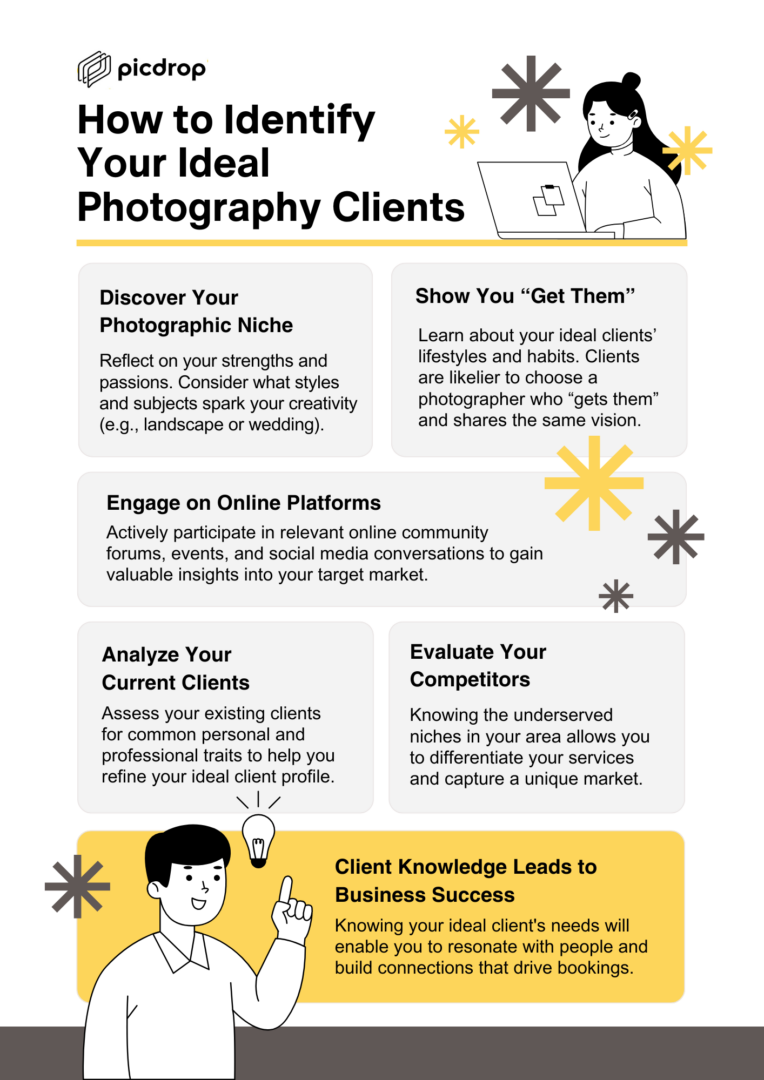
Photography marketing is one of the most important parts of building a sustainable photography business plan. Whether you’re a professional photographer aiming to book more clients or a hobbyist ready to turn passion into profit, the right photography marketing strategies (e.g., email marketing and social media for photographers) help you stand out in a competitive industry.
By understanding the benefits of marketing, defining your ideal client profile (ICP), and applying these strategies effectively, you can attract the right clients, build trust, and grow your photography business with purpose. This blog will walk you through each step to make your marketing photography more effective and focused.
Table of contents
Main Takeaways: What You Should Know About Marketing Your Photography Business
TL;DR: How to Promote Your Photography Business Online and Offline
What Are the Benefits of Photography Business Marketing?
How to Identify Your Ideal Photography Client
The 17 Best Photography Marketing Ideas to Grow Your Business
TL;DR: How to Market a Photography Business
Building a thriving photography business plan requires smart marketing photography tactics. These photography marketing ideas will help you attract the right clients, grow your reputation, and create long-term success:
- Build a strong brand and online presence: Define your brand identity, optimize your website for SEO, enhance your Google Business Profile, and use print materials to stand out. These photography marketing strategies build trust and visibility.
- Leverage digital marketing channels: Use social media to showcase your style, launch email marketing to stay connected, create blog content, share video, and run targeted ads. These tactics expand your reach and keep clients engaged.
- Strengthen client relationships: Highlight testimonials, run referral programs, offer mini sessions and promotions, and deliver a polished gallery experience with tools like picdrop. These steps turn one-time bookings into loyal repeat clients.
- Expand reach through community and data: Network with local businesses and other creatives, host events and exhibitions, and track results with analytics and feedback. This ensures your photography business plan evolves with your audience.
- By applying these photography marketing ideas consistently, you’ll transform your talent into a thriving business built on visibility, client loyalty, and steady growth.
Benefits of Photography Marketing for Your Business

Building a successful photography business goes far beyond capturing beautiful images. In today’s market, strategic photography marketing is the difference between a quiet inbox and a fully booked calendar. For professional photographers, investing in marketing means creating a sustainable business that attracts the right clients, builds long-term relationships, and increases earning potential.
Here’s why you should start adding marketing and promotional efforts to your photography business plan.
1. Photography Marketing Will Help You Attract Paying Clients
Thoughtful marketing photography efforts (whether through social media campaigns, a well-optimized website, or targeted email marketing outreach) help you reach an audience that appreciates your style and is willing to invest in your photography services. This targeted approach is essential for turning your portfolio from a showcase of talent into a steady source of revenue.
2. Promotion Will Make You Stand Out From Other Photographers
Effective photography marketing helps you differentiate yourself in a competitive industry. A strong brand voice and consistent messaging ensure your work is not just seen but remembered. A well-crafted photography marketing strategy transforms one-off projects into repeat bookings and client referrals. This is a key component of any photography business plan aimed at sustainability and professional recognition.
3. Marketing Will Help You Expand Your Reach and Charge Higher Rates
Photography marketing strategically allows you to extend your reach beyond local audiences, building a recognizable brand that conveys trust and professionalism. Engaging a wider audience turns casual viewers into loyal clients. As your reputation grows, so does your ability to command higher prices, aligning your fees with the perceived value of your work.
In essence, how to market your photography business is not just about promotion but also creating visibility, trust, and growth that support a thriving, long-term career.
How to Identify Your Ideal Photography Client for Effective Marketing

Before investing in photography marketing, you need to know who your ideal clients are. Remember, it’s not about attracting anyone who needs a photo service. It’s about finding those who resonate with your unique style, values, and business vision.
Here’s how to identify your ideal photography target market:
Reflect on your strengths and passions:
What kind of photography ignites your creative spark? Landscapes bathed in golden light? Candid moments capturing raw emotion? Edgy fashion shoots pulsating with energy? Identify your specialties and the emotions you evoke through your lens.
Explore your competitors:
Who are they targeting? What are their strengths and weaknesses? Can you identify an underserved niche within your specialty?
Dive into demographics and psychographics:
Age, location, and income are important, but go deeper. What are their hobbies, values, and aspirations? Are they nature enthusiasts seeking adventure portraits? Young entrepreneurs building a brand? Busy families cherishing milestone moments?
Get social (media, that is):
Engage with potential new clients online. Join relevant groups, participate in discussions, and analyze the types of photography and photographers they resonate with.
Analyze your current clientele (if any):
Look for patterns. What are their commonalities, both personal and professional? Use this information to refine your ideal client profile.
Remember:
Your ideal client is not a static image. They’re a living, breathing person with needs, desires, and a unique story. By understanding their world, you can tailor your marketing message to resonate with them on a deeper level, fostering genuine connections that translate into bookings.

The 17 Best Photography Marketing Ideas to Grow Your Business
These photography marketing ideas will give you simple, practical ways to attract more clients and strengthen your brand. These strategies focus on what works for photographers today, helping you grow your business with clear and actionable steps.
1. Set Up Your Photography Brand Identity

Imagine your brand as your unique artistic fingerprint. It’s not just a logo; it’s the carefully curated blend of visual style, personality, and values that attracts your ideal clients and makes them remember you. This strategy shines because it makes you more than just a name in the crowd – it makes you their go-to photographer.
Start by defining your photographic style and the emotions you want to evoke. Are you known for capturing candid joy, timeless elegance, or adventurous spontaneity? Design a logo that speaks your language, choose a color palette that reflects your mood, and craft a tagline that captures your essence.
Remember, consistency is key! Keep your website, business profiles, and marketing materials singing the same visual tune. This professional polish builds trust with prospective clients and sets you apart as the photographer who can translate their vision into reality.
Learn more: How to communicate your brand identity to clients
 Transform your brand into an experience!
Transform your brand into an experience!
picdrop simplifies sharing high-quality galleries and gathering feedback, ensuring your photography and brand identity shine through every interaction. Let picdrop be the tool that enhances your brand’s visual story, making every client collaboration memorable.
2. Promote Your Photo Services on Social Media
Think of social media as your vibrant online gallery, open 24/7 for potential clients to explore. Visual storytelling thrives on platforms like Instagram, Pinterest, and Facebook. But with countless platforms and endless content streams, being strategic is crucial.
To leverage this powerful tool, tailor your content to your ideal client’s preferred platforms. Showcase your work with stunning visuals that go beyond just portfolio highlights. Offer behind-the-scenes glimpses, creative tips, and even sneak peeks of upcoming projects.
Remember, it’s not just about posting to gain social media followers; it’s about fostering a community. Engage with your audience through comments and stories, host live sessions, and participate in relevant conversations. Build genuine connections and watch your online tribe grow.
Related: The best social media platforms for photographers
3. Build a Photography Email Marketing List
Email marketing is a direct line to your ideal clients. It lets you showcase your latest work, share exclusive offers, and stay connected. It’s like having your own fan club of photography enthusiasts who are eager to hear from you!
To build this loyal following, offer enticing sign-up incentives like discounts on future sessions or access to exclusive content. Place opt-in forms strategically on your website and social media channels. Once you have your list, craft engaging newsletters that showcase your latest projects, photography tips, or special deals.
Don’t forget that personalization is key! Segment your list based on interests and tailor your messages to resonate with each group. This way, you’ll avoid blasting generic emails and cultivate deeper connections with your fan club.
4. Showcase Client Testimonials
Client testimonials are like magic words in the marketing world, offering social proof of your incredible work. Potential new clients trust and connect with you more when they see glowing client reviews from satisfied customers. It’s like a friend recommending their favorite restaurant – you know it must be good!
To harness this power, ask your happy past clients and current clients for testimonials you can proudly display on your website and social media. Consider creating case studies of specific projects, showcasing before-and-afters, and detailing your process. This not only highlights your skills but also helps prospective clients envision how you can bring their unique projects to life.
5. Optimize Your Photography Website for SEO

In your digital marketing strategy, your website is your storefront window. That’s why Search Engine Optimization (SEO) is essential. It’s like putting up neon signs that attract more clients searching for photography magic. This strategy works by making your website easier for search engines to find, ultimately leading more curious eyes to your photography portfolio.
So, how do you sprinkle that SEO fairy dust? Start by understanding the keywords your target audience uses when searching for professional photographers. Think “wedding photographer in [your city]” or “family portrait photographers in [your city].” Sprinkle these keywords throughout your website, like glitter on a festive cake – in titles, descriptions, and even image tags. A good starting point is a SEO software that offers a free plan, like seobility does.
Remember to regularly update your website with fresh content like blog posts or project showcases — search engines love new things! A well-optimized website isn’t just about being seen; it’s about creating a welcoming experience that keeps visitors browsing.
6. Enhance Visibility with Google Business Pages
Imagine if every potential client in your city could easily find you on Google Maps. That’s the power of a Google Business Profile! This free listing is like a digital billboard, showcasing your business details and making it easy for more clients to discover you.
Claiming your profile is simple, but optimizing it is key. Ensure your contact information, services offered, and business hours are complete and up-to-date. Don’t forget to add stunning visuals of your work – think of them as irresistible invitations to click and explore. Encourage past clients to leave glowing reviews – social proof is like gold dust in the digital world! By maximizing your Google Business page, you’ll be on top of the map for local photography searches.
7. Network for Collaboration Opportunities
The photography world is a vibrant tapestry, and networking is the thread that weaves you into it. Connecting with other creatives and small business owners opens doors to exciting collaborations, fresh perspectives, and a wider audience for your work.
Imagine collaborating with a makeup artist, teaming up with another professional photographer for a workshop, or partnering with a local business for a special project – the endless possibilities! By actively seeking out and embracing collaborations, you’ll not only expand your network but also inject your portfolio with diverse and captivating content.
🔗 Looking to connect & collaborate effortlessly?
Streamline sharing and feedback for your collaborative projects, making every partnership smoother and more productive. With picdrop, connecting with other creatives and growing your portfolio has never been easier.
8. Engage in Content Marketing for Photographers
Content marketing is a strategic approach that involves creating and sharing valuable content to attract and engage a targeted audience. For many photographers, this could mean writing a blog post, creating videos, or sharing photo essays that showcase your expertise and style. This strategy is effective because it helps build your brand, improves SEO, and establishes you as an authority in your field.
To implement it, start a blog on your website where you can share behind-the-scenes stories, photography tips, or client case studies. You can also create tutorial videos or photo documentaries and share them on social media and YouTube. Consistently delivering engaging and informative content not only helps attract clients but also keeps your current clients interested and coming back for more.
9. Implement Referral Programs

Referral programs encourage your satisfied clients to refer new clients to you, often in exchange for rewards. This strategy leverages word-of-mouth marketing, which can be incredibly effective in photography, as personal recommendations carry significant weight.
To implement a referral program, offer incentives like discounts, free prints, or special sessions for clients who refer new business opportunities to you. Make sure to communicate the details of your referral program to your clients, and consider creating referral cards or emails that they can easily share with friends and family.
10. Use Targeted Online Advertising on Your Brand
Targeted online advertising allows you to reach specific groups of potential clients with ads tailored to their interests and online behaviors. Platforms like Facebook, Instagram, and Google Ads offer sophisticated targeting options based on demographics, interests, location, and more. This strategy is effective because it places your photography services directly in front of people who are most likely to be interested in them.
To get started, define your target audience and set a budget. Create visually appealing ads that showcase your best work and include a clear call-to-action. Regularly review the performance of your ads and adjust your strategy as needed to improve results.
11. Provide Promotional Deals, Packages, and Giveaways
Offering promotional deals and packages and hosting giveaways can attract new clients and retain existing ones. These promotions create excitement and urgency, encouraging potential clients to book your services.
For example, you could offer a limited-time discount on portrait sessions or create special packages for events like weddings or family shoots. Giveaways, where participants can win a free session or prints, can be particularly effective when combined with social media, increasing your visibility and engagement. Ensure that your promotions and giveaways are well-advertised on your website, social media, and email marketing to reach a broad audience.
12. Host Photography Events and Exhibitions
Hosting photography events and exhibitions is an effective way to showcase your work, build your brand, and network with potential clients and other industry professionals. This strategy allows you to present your portfolio in a professional and engaging setting, making a lasting impression.
To implement this, choose a theme that represents your best work or a new project you want to promote. Find a suitable venue, like local galleries or community spaces, and promote the event through social media, your website, and local press. You can also offer exclusive deals or book sessions during the event. Hosting an exhibition or local event not only displays your talent but also puts a face to your brand, making it a personal experience for attendees.
13. Collaborate with Local Businesses (Co-Marketing)

Collaborating with local businesses, also known as co-marketing, can open new avenues for exposure and client referrals. This strategy works because it taps into the existing customer base of the businesses you partner with, increasing your reach.
Find co-marketing partners that complement your photography niche, such as wedding planning businesses, real estate agents, or interior designers. Offer to provide them with professional photography services that can enhance their own marketing efforts. In exchange, they can refer you to their clients or display your work on their premises. Building these local partnerships helps embed your brand in the local community and can lead to a steady stream of referrals.
14. Utilize Print Marketing Materials
Despite the digital age, print marketing materials like business cards, brochures, and flyers remain effective tools for photographers. They provide a tangible way to showcase your work and leave potential clients with a physical reminder of your brand.
To use this strategy effectively, ensure your print materials reflect your brand identity and include your best images, services offered, and contact information. Distribute them at local businesses, events, exhibitions, or when meeting potential clients in person. High-quality print materials can make a strong impression and serve as a quick reference for people to recall and contact you.
15. Offer Mini Photo Sessions
Mini sessions are short, affordable photo shoots that are particularly appealing to clients looking for a quick and budget-friendly option. This strategy is effective because it attracts clients who might not be ready for a full session, provides a taste of your services, and can lead to longer bookings in the future.
To offer mini photography sessions, choose a specific theme or occasion, like holiday portraits or springtime family photos, and promote them through your marketing channels. Ensure the sessions are easy to book and offer a fast turnaround on photos. Mini sessions not only fill your schedule during slower times but also provide an opportunity for clients to experience your work, potentially leading to more extensive projects.
16. Share Video Content
Sharing video content is an increasingly popular and effective marketing strategy for photographers, especially in an era where visual storytelling is paramount. Videos can showcase your work, process, and personality in a dynamic way that still images alone cannot. This approach is effective because it engages audiences more deeply, often leading to higher interaction and sharing rates.
To implement this, consider creating behind-the-scenes videos of your photoshoots, tutorials, or client testimonials. Share these videos on your website, social media platforms, and YouTube. With picdrop supporting video sharing, it becomes an ideal platform for photographers who also work with video content. picdrop can easily share and receive feedback on your photographic and video content, streamlining your workflow and client interaction.
17. Implement Data Analytics and Feedback Mechanisms

Utilizing data analytics and feedback mechanisms is crucial for understanding the effectiveness of your marketing strategies and improving client satisfaction. This approach allows you to make data-driven decisions and tailor your marketing efforts more precisely.
Implement this by using tools like Google Analytics to track website traffic, engagement, and conversion rates. Regularly review which pages are most visited and how users interact with your content.
Additionally, gather client feedback through surveys, feedback forms, or direct communication. This feedback is invaluable for understanding client needs and preferences and identifying areas you can improve for future clients. By analyzing data and feedback, you can refine your marketing tactics, enhance client experience, and ultimately drive more business.
 Want to simplify client feedback and save time?
Want to simplify client feedback and save time?
picdrop transforms the way you interact with clients, offering easy sharing, secure galleries, and efficient feedback collection. Say goodbye to time-consuming emails and manual sorting, and hello to more creative time.
Deliver Great Client Experiences with picdrop
Delivering great client experiences is one of the best ways to retain customers and attract new ones through word-of-mouth marketing. That’s where professional photo-sharing software like picdrop comes in handy.
The benefits of using picdrop are significant. It offers a hassle-free experience for both you and your clients. After a photoshoot, clients can effortlessly download images, make their selections through intuitive color markings, vote on their favorites, and provide direct feedback and comments. This streamlined process not only saves valuable time but also actively involves your clients in the selection process, thereby enhancing their overall experience with your services.
Want to experience picdrop’s benefits for photographers? Sign up for our client photo gallery software for free to try things out for yourself.
Photography marketing FAQs
Find answers to common questions about promoting your photography business online and offline.
What is photography marketing?
Photography marketing involves promoting your photography services to attract and engage clients. It encompasses a range of activities, from showcasing your portfolio and using social media marketing to networking and implementing targeted advertising. The goal is to build your brand, increase visibility, and ultimately drive business growth by connecting with potential clients who appreciate and seek your photography style and expertise.
Who is the target market for photographers?
The target market for photographers varies based on their niche and style. It can range from individuals seeking personal portraits, couples looking for wedding photographers, businesses in need of commercial imagery, to art collectors interested in fine art photography. Identifying your target market involves understanding who values your specific style and services and is willing to pay for them.
How do I market myself as a photographer?
Market yourself as a photographer by building a strong brand, showcasing your work through a professional portfolio, using social media platforms, engaging in networking, and participating in local events. Consistent branding, sharing compelling content, and establishing connections in the photography community are key. Offering excellent customer service and leveraging client testimonials can also significantly enhance your marketing efforts.
How do I market my photos?
Market your photos by displaying them on various online platforms, including a personal website, social media accounts, and photography forums. High-quality, consistent content that aligns with your brand helps attract attention. Consider selling your photos through stock photography websites, participating in exhibitions, or using print marketing materials. Engaging storytelling and context around your photos can also enhance their appeal.
How do photographers promote their business?
Photographers promote their business through a combination of online and offline strategies. This includes having a strong website and social media presence), leveraging SEO, engaging in content marketing, networking, collaborating with other creatives, participating in local events, and using traditional advertising methods. Staying active in the photography community and consistently showcasing your latest work are also crucial for promotion.
How do I create a photography marketing plan?
Create a photography marketing plan by first defining your target market and unique selling proposition. Set clear marketing goals and objectives. Identify the best channels to reach your audience, such as social media, email marketing, or local advertising. Plan your content strategy, set a budget, and establish a timeline. Regularly review and adjust your plan based on performance and feedback.
Where is the best place to advertise photography services?
The best place to advertise photography services depends on your target market. Online platforms like social media channels (especially visually-oriented ones like Instagram), your personal website, and photography forums are great for reaching a broad audience. Local advertising in community centers, event spaces, and collaborations with local businesses can be effective for local market penetration. Also, consider online advertising through Google Ads or social media ads for targeted outreach.



